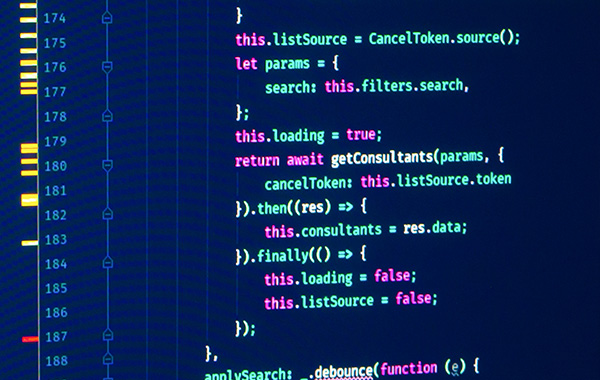JavaScript Code Quality Analysis Solution
DeepScan®

Trend
JavaScript Code Quality Analysis Solution
-
 Expansion of JavaScript development area
Expansion of JavaScript development area
JavaScript is being used not only in the traditional web UI, but also in all areas of development, including server applications, mobile apps, desktop applications, and IoT. As a result, the amount of JavaScript code is increasing rapidly and the code complexity is increasing, leading to the emergence of quality problems. Although it is suitable for rapid development due to the nature of the language, it is difficult to debug and test, so the demand for quality control is increasing. -
 Rapid increase in developer demand
Rapid increase in developer demand
JavaScript is getting more and more spotlight as it can greatly improve productivity at client/server development through code sharing using a single language. It has been selected as GitHub’s most popular language for many years and is the number one language for job openings on developer recruitment sites. On the other hand, the lack of skilled developers continues, and the code of unskilled developers have a big impact on product quality. -
 Language specifications and frameworks that are constantly updated
Language specifications and frameworks that are constantly updated
JavaScript is rapidly changing as new specifications are added every year, and various frameworks, such as React and Vue.js, along with numerous libraries are also changing in accordance with the trend. It is very difficult for general companies to keep up with and respond to this trend.
Services Provided
JavaScript Code Quality Analysis Solution – DeepScan®
Prevent JavaScript code problems beforehand and increase the productivity of developers and quality managers.
Overview
We faithfully support the latest development trends while focusing on the detection of significant execution errors through differentiated JavaScript analysis techniques.
As JavaScript is widely used regardless of the front and back end, development productivity decreases and maintenance difficulties are emerging as code increases. Due to the nature of the language, code problems are discovered late, resulting in an increase in quality costs, and there is also a shortage of experienced developers. DeepScan improves developer productivity and lowers ever-increasing quality costs by analyzing and solving JavaScript code problems in advance during the development stage.
Major Functions
- High-quality JavaScript analysis engine
DeepScan engine detects complex and potential problems beforehand through execution flow analysis. It improves productivity with a low false positive rate of less than 5% and fast processing speed analyzing thousands of lines per second. - Various and accurate latest verification rules
Provide continuous updates that reflect the latest JavaScript and TypeScript specifications and the latest technology trends, such as React and Vue.js. - Convenient quality control
Provide a rating compared to high-quality open source projects so that quality managers can quantitatively understand the quality of their projects. By providing the severity level for each issue, it is possible to gradually deal with important issues. - Development workflow integration
Tools including SonarQube plug-ins, editor plug-ins, command line tools (CLI), and on-premise that can be applied to all stages of development are provided and seamlessly applied to the customer’s development workflow.
Strength
-
 High-quality JavaScript analysis engine
High-quality JavaScript analysis engine
Support the latest JavaScript and development frameworks, such as ES2020+ standard, TypeScript, Node.js, React, and Vue.js, and detect problems that the existing syntax tree-based tools(Linter) cannot find. -
 Small noise and easy troubleshooting
Small noise and easy troubleshooting
Through various filtering techniques, only problems that need to be corrected are accurately detected, and detailed causes are provided so that problems can be easily corrected. -
 Productivity improvement and quality cost reduction
Productivity improvement and quality cost reduction
By preventing code problems in advance, quality costs are reduced, and problems can be classified according to severity, allowing priority response to important issues. In addition, various tools, such as on-premises and CLI, are provided to easily integrate with workflows, such as development, build, and code review. -
 Proven global service
Proven global service
It is used by a wide range of customers in dozens of countries through SaaS (www.deepscan.io), always provides the latest updates and responds quickly to VoC.

DeepScan provided through SaaS
Visit – www.deepscan.io
Customer Case
Challenges
Company A, a global software developer, used JavaScript in almost all projects, and there were increasing cases of adopting Node.js for back-end server as well. Accordingly, in managing the quality of JavaScript code, which is becoming increasingly complex, company A was having difficulty in coping with the existing quality control tools.
Company B, a digital marketing platform company, provides tools and platforms for creating advertisements for the web. Company B was using the latest web technology to satisfy various customer needs and to create creative advertisements, but company B wanted to have more reliability in the quality of code according to the latest trends.
Company C, which develops medical applications, is a startup providing mobile and web applications for healthcare. Company C does not have enough quality control personnel for developing web technology-based applications to quickly develop and supply good ideas. There was a need for an inexpensive way to maximize the quality of the application.
S-core Services
Company A introduced DeepScan as an in-house JavaScript standard quality control tool and easily applied it to the existing workflow. It was also applied to developer tools, leading to solving quality problems faster.
Company B and Company C were using GitHub, and they easily introduced the DeepScan SaaS service to perform code quality checks for all code changes at low cost without additional workflow integration development.
Effects
Using DeepScan, the quality control of the source code of SW products developed with JavaScript has become easier.
Quantitative effect
– Reduced quality costs by finding and solving problems quickly.
– Eliminated additional integration costs by integrating into existing workflows easily
– Classified problems according to severity and responded first to important issues to improve efficiency of development resource input
Qualitative effect
– Reduced developer resistance to adopt quality tools through effective analysis results.
– Improved work efficiency of quality managers as the quality status of the code can always be checked.
– Helped unskilled developers write high-quality code faster.
Ask Us Anything
If you leave an inquiry with us, we will provide you with a swift, detailed response.
Get in Touch







